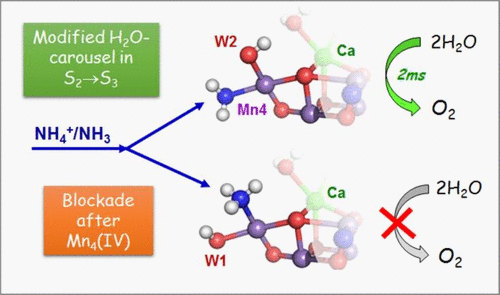当前位置:
X-MOL 学术
›
Biochemistry
›
论文详情
Our official English website, www.x-mol.net, welcomes your
feedback! (Note: you will need to create a separate account there.)
Inhibitory and Non-Inhibitory NH3 Binding at the Water-Oxidizing Manganese Complex of Photosystem II Suggests Possible Sites and a Rearrangement Mode of Substrate Water Molecules
Biochemistry ( IF 2.9 ) Pub Date : 2017-11-13 00:00:00 , DOI: 10.1021/acs.biochem.7b00743 Nils Schuth 1 , Zhiyong Liang 1 , Matthias Schönborn 1 , André Kussicke 1 , Ricardo Assunção 1 , Ivelina Zaharieva 1 , Yvonne Zilliges 1 , Holger Dau 1
Biochemistry ( IF 2.9 ) Pub Date : 2017-11-13 00:00:00 , DOI: 10.1021/acs.biochem.7b00743 Nils Schuth 1 , Zhiyong Liang 1 , Matthias Schönborn 1 , André Kussicke 1 , Ricardo Assunção 1 , Ivelina Zaharieva 1 , Yvonne Zilliges 1 , Holger Dau 1
Affiliation

|
The identity and rearrangements of substrate water molecules in photosystem II (PSII) water oxidation are of great mechanistic interest and addressed herein by comprehensive analysis of NH4+/NH3 binding. Time-resolved detection of O2 formation and recombination fluorescence as well as Fourier transform infrared (FTIR) difference spectroscopy on plant PSII membrane particles reveals the following. (1) Partial inhibition in NH4Cl buffer occurs with a pH-independent binding constant of ∼25 mM, which does not result from decelerated O2 formation, but from complete blockage of a major PSII fraction (∼60%) after reaching the Mn(IV)4 (S3) state. (2) The non-inhibited PSII fraction advances through the reaction cycle, but modified nuclear rearrangements are suggested by FTIR difference spectroscopy. (3) Partial inhibition can be explained by anticooperative (mutually exclusive) NH3 binding to one inhibitory and one non-inhibitory site; these two sites may correspond to two water molecules terminally bound to the “dangling” Mn ion. (4) Unexpectedly strong modifications of the FTIR difference spectra suggest that in the non-inhibited PSII, ammonia binding obliterates the need for some of the nuclear rearrangements occurring in the S2–S3 transition as well as their reversal in the O2 formation transition, in line with the carousel mechanism [Askerka, M., et al. (2015) Biochemistry 54, 5783]. (5) We observe the same partial inhibition of PSII by NH4Cl also for thylakoid membranes prepared from mesophilic and thermophilic cyanobacteria, suggesting that the results described above are valid for plant and cyanobacterial PSII.
中文翻译:

光系统II的水氧化锰配合物上的抑制性和非抑制性NH 3结合表明底物水分子的可能位点和重排模式
光系统II(PSII)水氧化中底物水分子的身份和重排具有极大的机械意义,本文通过对NH 4 + / NH 3结合进行全面分析来解决。在植物PSII膜颗粒上对O 2的形成和重组荧光进行时间分辨检测以及傅立叶变换红外(FTIR)差异光谱表明:(1)在NH 4 Cl缓冲液中发生部分抑制时,pH无关的结合常数约为25 mM,这不是由O 2形成的减速引起的,而是由主要PSII组分(约60%)完全被阻断后形成的。锰(IV)4(S 3) 状态。(2)非抑制性PSII组分在整个反应周期中都在前进,但FTIR差光谱法则表明了修饰后的核重排。(3)部分抑制可以通过NH 3与一个抑制位点和一个非抑制位点的结合(互斥)来解释。这两个位点可以对应于两个与“悬空” Mn离子末端结合的水分子。(4)FTIR差异光谱的出乎意料的强烈变化表明,在非抑制性PSII中,氨结合消除了对在S 2 -S 3转变中发生的某些核重排以及它们在O 2形成中的逆转的需要。轮播机制[Askerka,M.,et al。(2015年)生物化学54,5783]。(5)对于由嗜温和嗜热蓝细菌制备的类囊体膜,我们也观察到NH 4 Cl对PSII的部分抑制,这表明上述结果对于植物和蓝细菌PSII是有效的。
更新日期:2017-11-14
中文翻译:

光系统II的水氧化锰配合物上的抑制性和非抑制性NH 3结合表明底物水分子的可能位点和重排模式
光系统II(PSII)水氧化中底物水分子的身份和重排具有极大的机械意义,本文通过对NH 4 + / NH 3结合进行全面分析来解决。在植物PSII膜颗粒上对O 2的形成和重组荧光进行时间分辨检测以及傅立叶变换红外(FTIR)差异光谱表明:(1)在NH 4 Cl缓冲液中发生部分抑制时,pH无关的结合常数约为25 mM,这不是由O 2形成的减速引起的,而是由主要PSII组分(约60%)完全被阻断后形成的。锰(IV)4(S 3) 状态。(2)非抑制性PSII组分在整个反应周期中都在前进,但FTIR差光谱法则表明了修饰后的核重排。(3)部分抑制可以通过NH 3与一个抑制位点和一个非抑制位点的结合(互斥)来解释。这两个位点可以对应于两个与“悬空” Mn离子末端结合的水分子。(4)FTIR差异光谱的出乎意料的强烈变化表明,在非抑制性PSII中,氨结合消除了对在S 2 -S 3转变中发生的某些核重排以及它们在O 2形成中的逆转的需要。轮播机制[Askerka,M.,et al。(2015年)生物化学54,5783]。(5)对于由嗜温和嗜热蓝细菌制备的类囊体膜,我们也观察到NH 4 Cl对PSII的部分抑制,这表明上述结果对于植物和蓝细菌PSII是有效的。











































 京公网安备 11010802027423号
京公网安备 11010802027423号